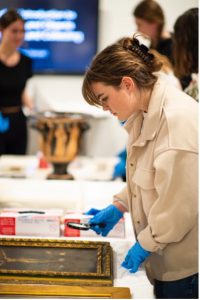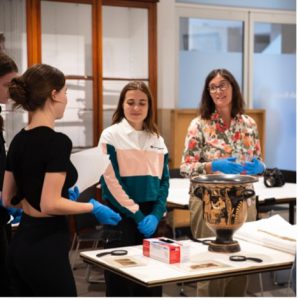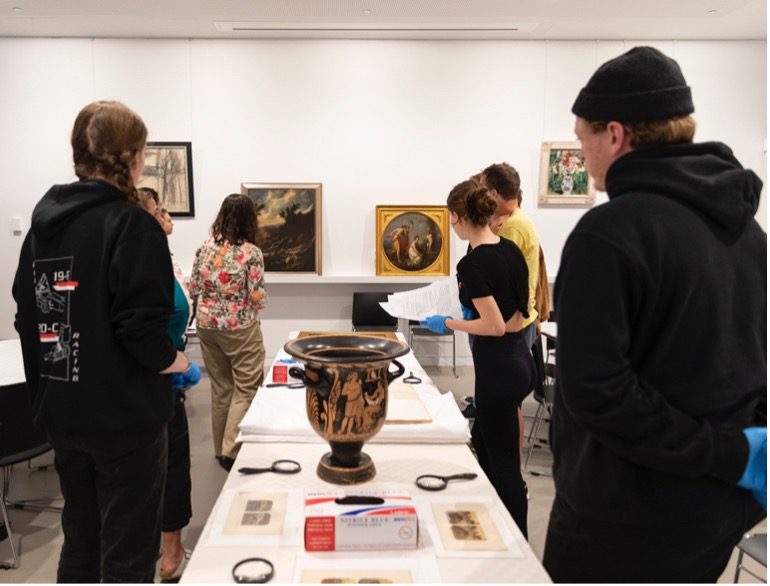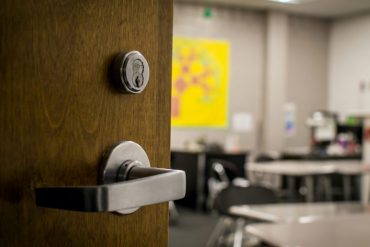Online by Our Design platforms the innovative teaching practices across the Faculty of Arts and Social Sciences generated by the shift to online learning and new technologies and resources. Engagement is core to the faculty’s pedagogical values, and the University of Sydney’s academics are uniquely positioned to engage with history in new ways with the opening of the Chau Chak Wing Museum.
Cindy McCreery is a Cultural Historian and Senior Lecturer in the Department of History at the University of Sydney. In 2021, Cindy won the FASS Excellence in Teaching award for her innovative and creative approach to teaching, making the most of technological opportunities and the university’s new Chau Chak Wing Museum.
Leanne: I’m fascinated with what you’ve done in the digital space with this unit. Where did you where did you start? What was the idea and what training did you need to execute it?
Cindy: Basically, it started with a lot of thought about how I could engage with the new Chau Chak Wing (CCW) Museum. I’ve long had a genuine interest in material culture and visual culture, and I’ve always brought that into my teaching but up until now it’s been through PowerPoint slides or looking at online museum exhibitions in the classroom and I just thought would be wonderful to take advantage of CCW. I did the National Centre for Cultural Competence program and one of the staff members from CCW was in one of our breakout sessions, he was talking about the collection and about what he was doing and so that got me really interested. And I already knew people like the Curator of Macleay, so I just thought it was a wonderful opportunity to do something.
I teach a unit in 18th century British and Irish history, but I really wanted to make it more relevant for people, because that’s a period of history that is no longer taught much in Australia or indeed in history in general. For a lot of students, they have a sense of apprehension about dealing with a period that, for them, seems so remote and far away. I really want to make this history come alive. And then CCW advertised some object-based learning and training for staff, and I did one of those seminars, I got to meet Jane Thogersen, (the Academic Engagement Curator) and the Academic Liaison Curator there. We had a series of conversations; they were very positive and very helpful and it just sort of grew from there.
I did the group training in February at CCW and in addition to that, I had about three sessions in the CCW study room with the Academic Liaison Officer (Jane Thorgersen), our education Designer (Bec Plumbe) from SOPHI e-Learning and Peter Adams, who’s our fantastic Software and Assets Officer in SOPHI, figuring out what worked. Our Education Designer was instrumental, she knows how I teach, and she knows what I needed. And our Software Assets Officer was able to supply the additional equipment we needed, like visualisers.
In the classroom, we had a huge touch screen in the room, which allowed us to look at objects online. Because it’s so big you can find an item in the British Museum collection and compare it with what we were looking at in the room in CCW. And then for the Zoom students, what I like about the touch screen in teh room is it’s so big I can see the students and I walk up close to them, and it feels much more intimate than a normal Zoom meeting because I’m physically close to them and they’re full size in the room.
Leanne: This is it for first semester 2021, and you still had a portion of students studying remotely?

Cindy: Yes. We had a one-hour HyFlex lecture with students joining remotely as well as in-person students in the Quad Refectory classroom. Then we broke into separate groups over 3 classes in CCW, because what I realised is the zoom students need a break, it would not have worked to have the HyFlex lecture, then do a zoom seminar; zoom students needed an hour break. Whereas students on campus, it suits them often to do their in-class learning in a block because they’ve got other things to do, so that worked really well.
The Academic Engagement Curator gave students a great safety briefing in week one and part of it was just breaking down students’ apprehension about ‘oh my God, this is a priceless object’ and saying, ‘hey guys, this is a learning tool’ and we are actually allowed to touch and lift up things. In the 18th century, they did a lot of plaster casts of ancient statues as learning tools, and museums in the 19th century and 20th century also used them for teaching. There was a plastic plaster cast of a statue and the students thought it was marble and I just took my left hand and I just started tapping it. I wanted to show students,
it’s plastic, you’re allowed to touch this, this is a teaching tool and I’m teaching you in a way that if you had been at university probably up to the 1970s, but certainly the 19th century, this is how you would have engaged with the ancient world.
We had some great guest talks from the CCW curators, and we had different curators take us through different parts of the exhibition; the whole message for students was we’re in a 21st-century Australian university. The reason we have all this stuff is because of patronage and collecting practices, but also the notion of elite culture, and so we talked about how we are the heirs of this and the complexity of what we’re dealing with. There’s this legacy of an 18th-century British cultural idea that Britain is an enlightened nation, that it’s a civilising society, and that university students in the colonies in the 19th century should be taught about the past in particular ways. So, we talked about patronage and collectors, and we talked about Chau Chak Wing, we talked about power, the power of collection and we talked about people like William Macleay and Charles Nicholson in particular because that’s all relevant to what we were doing.
Leanne: I find it really empowering that you tell your students that they are historians, that while they are studying this unit, they’re historians too. In small and large ways, you built opportunities for students to develop their agency as historians, can you tell me about that?

Cindy: That’s been part of my practice as a teacher for a long time, I do it in all my units and put a big emphasis on that in my first-year teaching, because it’s so important to shepherd new students through that process of moving from thinking like a high school student to thinking like a university student. I want them to become aware that we are all in a community of scholars. Okay, we’re at different stages on that path, but we must start thinking like historians and have a lot of pride and courage in our work as historians and so that means thinking independently, listening, as well as speaking in a group setting and but also just giving them the confidence to think that they can provide a useful contribution to the ongoing historical conversation.
One of the things I do is re-present and adapt for a modern audience a very famous speech by Vico, the 17th-century Neapolitan philosopher, it’s the opening address to incoming students, which of course meant all male students at Naples University in the 17th century. I adapt that for University of Sydney students, and instead of talking about young Italian noble men I talk about people of all genders and backgrounds, but really trying to keep the sense of:
this is an amazing opportunity for you, you have all the ability and talents you need for this, be open to learning and have confidence that you can do it.
I was really trying to extend this further in the unit engaging with material culture: it’s not just about reading and discussing and writing about history, what you’re doing in this unit is what real historians, curators, and gallery professionals do. Students are working with objects, they’re reflecting on them, they’re adding to a conversation about them.
I really think that this is an example of what we can do, what other teachers can do in different ways, and you don’t have to have it wholly based in CCW, teachers can make use of having one week where you go to CCW, but I would say it is really adaptive; this kind of teaching with material culture from our own collections is the future for us at the University of Sydney, to distinguish ourselves from our colleagues all around the world. With online lectures, global education, I think we need to be mindful of what we at the University of Sydney can really bring that is new and different. Anyone can do a Zoom lecture. We need to build and develop, and protect our particular value as academics, so I would encourage colleagues to think about this really carefully.
Want to know more?
- Book a visit to the Chau Chak Wing Museum
- National centre for Cultural Competence https://www.sydney.edu.au/nccc/
- Contact your FASS Education Designer





